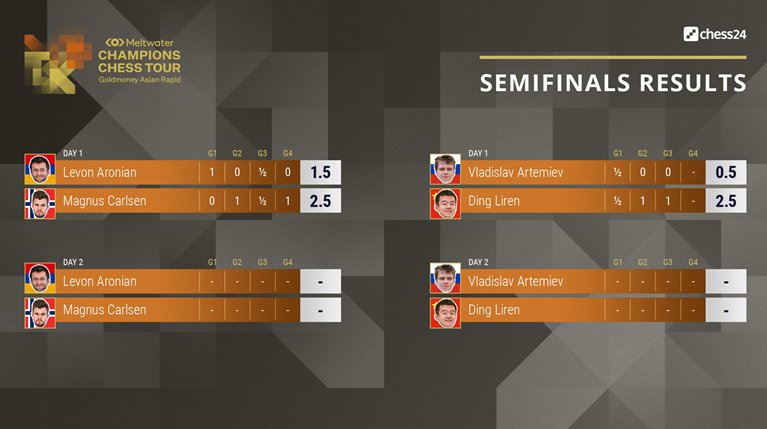.jpeg)

.jpeg)
After Magnus Carlsen overcame the difficult hurdle of Wesley So in the quarterfinals, he now faced Levon Aronian in the semifinals. The Armenian, who will soon be playing under the US flag, had won the preliminary round and is not exactly a walk-on. The first game was promptly lost for the World Champion. Out of the opening, Carlsen got into a somewhat unfavourable position in a Ruy Lopez. White forced the exchange of queens, which increased his advantage.
Black is uncomfortable, as the white centre pawns hinder his play.
26.Raa1 Bc8 [26...Rc2!?]
27.Qd4 Qxd4 [27...Nd7!?]
28.Nxd4 Bd7?! The idea is a5. But the white trick is not very strong. [Perhaps keeping still with 28...Bb7!? 29.f3 Rc3 was better.]
29.f3 [29.Rxa6 Nxd5]
29...a5 The two black passed pawns look better than they really are. One is lost immediately.
30.Reb1 [30.Rxa5? Nxd5]
30...a4 31.Nxb5 Rc2 32.Nf1 Ra8 33.Na3 Rc3 34.Rc1 Rac8 35.Rxc3 Rxc3 36.Ng3 Ne8 37.Ne2 Rd3? Proves to be an unfavourable square for the rook. [Better was 37...Rb3]
38.Nc4 With the ugly fork threat on e5.
38...Bb5 39.Ne5 Rd2 40.Nc3 Nd6 41.Nxb5 Nxb5 42.Rxa4 The rest is technical for White.
42...f5 43.h4 fxe4 44.fxe4 Kf8 45.Nf3 Rd3 46.Kf2 Ke7 47.Kg3 Nc3 48.Rc4 1–0
Carlsen recovered quickly, however, and struck back in the very next game, in which he had the white pieces. From a typical isolani position, the Norwegian reached an advantageous endgame (analysed by Karsten Müller below).
After a draw in game three, Carlsen outplayed Aronian in the fourth game out of a London System, but still needed his opponent’s help to win the point after a hasty move.
Here Carlsen saw the time had come to use force.
34.Nxd5 Rxd5 [34...exd5 35.e6 Bxe6 36.Re2 Rd6 37.Qe1]
35.Nxf7 Nxf7 36.Bxd5 exd5 37.Rxg7 Ngh6 38.Qg2 Ng4 39.Rxg4 [39.Rg6 was also okay.]
39...fxg4 40.Qxg4 Ke8
41.f5 The three white pawns more than compensate for the piece.
41...Nxe5 There is no other way to stop the advance of the pawns.
42.dxe5 Qxe5 43.f6? Too hasty. [More precise was 43.Qg6+ Kd8 44.Kb1 winning.]
43...Qe3+ 44.Kb1 Qe4+ 45.Qxe4+ dxe4
46.Rh1? [White would have kept his advantage with 46.Rg5 Kf7 47.Kc2 Kxf6 48.Rxb5]
46...Kf7 Now the endgame is drawn.
47.h6 Kxf6 48.Kc1 Rd8 Merely!
49.Rd1
49...Rd3 [49...Rh8 is also enough for a draw. 50.Rd5 Rxh6 51.Rxb5 Rh2 52.Rc5 e3 53.Kd1]
50.Rh1 Rd8 Again the only move.
51.h7 Kg7 52.Rh5 Re8? [52...e3 is drawn, e.g: 53.h8Q+ Rxh8 54.Rxh8 Kxh8 55.Kd1 Kg7 56.Ke2 Kf6 57.Kxe3 Ke5]
53.Kd2 e3+ 54.Ke2 Kh8 The pawn endgame would now be lost.
55.Rxb5 Kxh7 56.Rb4 Kg6 57.Rxc4 Ra8 58.Kxe3 Kf5 59.Kd3 Ke5 60.Rb4 Kd5 61.c4+ Kc6 62.Kc3 Ra5 63.Rb5 Ra7 64.Kb4 Ra8 65.Ra5 Rb8+ 66.Kc3 1–0
In the second semifinal between Ding Liren and Vladislav Artemiev the Chinese GM won the second and third games after a draw in the first encounter of the day.
